Audio Performance
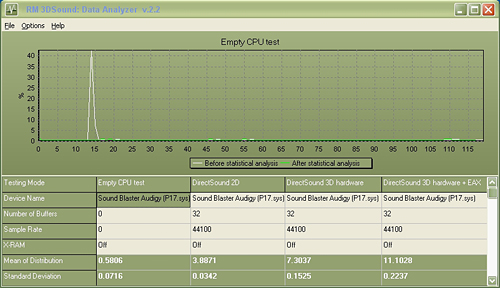
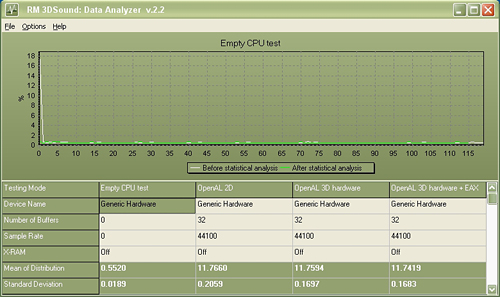
We limited audio testing to the Rightmark 3D Sound version 2.2 CPU utilization test and tested with sound enabled to show the performance effects on several games. The Rightmark 3D Sound benchmark measures the overhead or CPU utilization required by a codec or hardware audio chip.
The Realtek HD audio codec family was tested with the recently released 1.34 driver set and the Realtek AC97 codecs with the 3.84 driver set. We tested the Sound Blaster Audigy SE with the 5.12.1.519 driver set. The Realtek HD DirectSound audio drivers do not support more than 32 hardware buffers and the OpenAL 1.1 drivers do not support more than 30 hardware buffers at this time so the scores cannot be directly compared to the Creative Labs Sound Blaster X-FI and Sound Blaster Audigy SE in the benchmarks.
Although Creative Labs is marketing the CA0106-DAT codec as a Sound Blaster Audigy SE, it is actually the same chipset used in the Sound Blaster Live! 24-bit family of products. The CA0106-DAT is paired with the excellent Wolfson WM8775 ADC and Cirus Logic CS4382 DAC to provide 8-channel audio capability, 100dB SNR rating, and 24-bit/96KHz operation. This combination fully supports EAX 1/2/3 and OpenAL 1.1 but did not provide EAX3 (HD) positional audio via hardware in our testing.
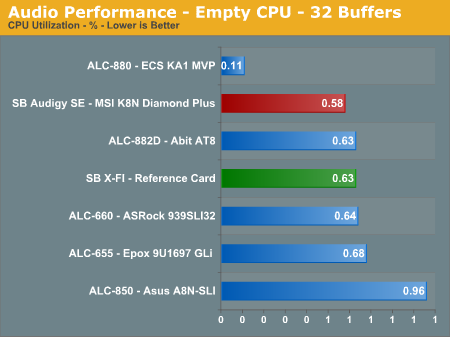
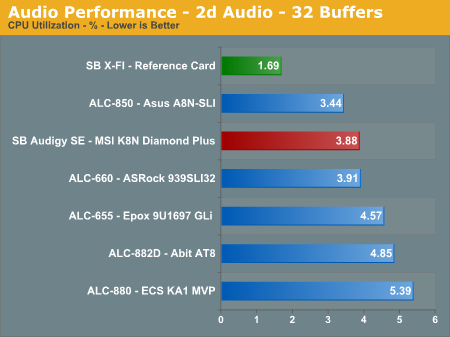
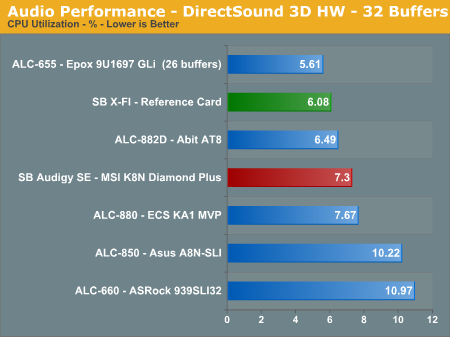
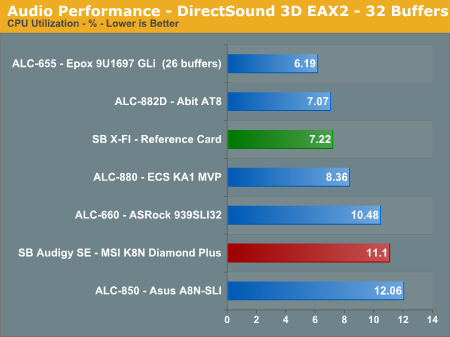
The Sound Blaster Audigy SE codec offers competitive CPU utilization rates when compared to the Realtek series of codecs. The SB Audigy SE generates better gaming audio quality than the Realtek ALC-882 based systems and similar DVD/music audio quality. In our subjective headphone testing we noticed differences between the two codecs, with the output from the ALC-882 sounding cleaner in the mid-range tones with deeper bass in the music and DVD movie playback tests while ambient sounds and positioning in the games tests clearly favored the SB Audigy SE. However, the difference was minor when utilizing our 4, 5.1, or 7.1 speaker setup in a typical room environment. The Sound Blaster X-FI has the lowest overall rates with the Realtek solutions and SB Audigy SE following closely. Let's find out how these results translate into real world numbers.
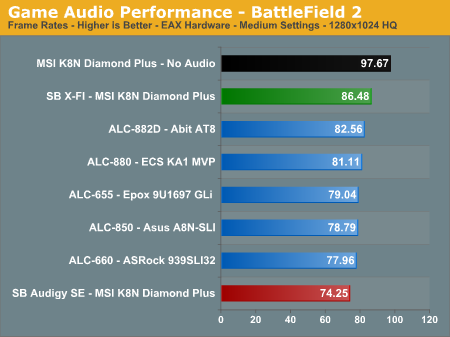
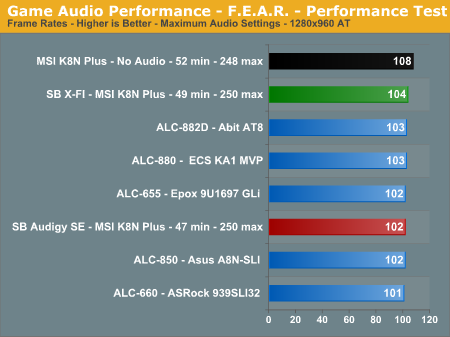
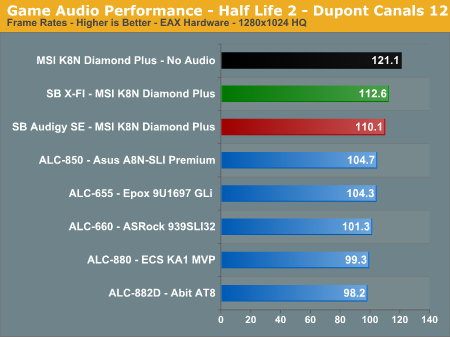
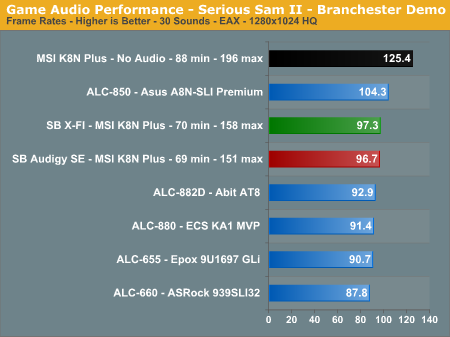
The audio performance numbers remain consistent as the Sound Blaster Audigy SE finishes behind the SoundBlaster X-FI while trading places with the Realtek audio solutions. Serious Sam II has an average loss of 30%, Battlefield 2 at 31%, Half Life 2 at 10%, and F.E.A.R. at 6%.
The output quality of audio with the Sound Blaster Audigy SE ranks closely with the Realtek ALC-882/883, while game performance is impressive for an on-board solution. The vast majority of users should have no issues utilizing the SB Audigy SE as their primary audio solution considering the audio quality and performance at this time.
Obviously, if you are a serious gamer, then a dedicated sound card is still useful to ensure consistent frame rate averages across a wide variety of games, and in the case of the Sound Blaster X-FI you also get improved audio quality and EAX4/5 support.


We limited audio testing to the Rightmark 3D Sound version 2.2 CPU utilization test and tested with sound enabled to show the performance effects on several games. The Rightmark 3D Sound benchmark measures the overhead or CPU utilization required by a codec or hardware audio chip.
The Realtek HD audio codec family was tested with the recently released 1.34 driver set and the Realtek AC97 codecs with the 3.84 driver set. We tested the Sound Blaster Audigy SE with the 5.12.1.519 driver set. The Realtek HD DirectSound audio drivers do not support more than 32 hardware buffers and the OpenAL 1.1 drivers do not support more than 30 hardware buffers at this time so the scores cannot be directly compared to the Creative Labs Sound Blaster X-FI and Sound Blaster Audigy SE in the benchmarks.
Although Creative Labs is marketing the CA0106-DAT codec as a Sound Blaster Audigy SE, it is actually the same chipset used in the Sound Blaster Live! 24-bit family of products. The CA0106-DAT is paired with the excellent Wolfson WM8775 ADC and Cirus Logic CS4382 DAC to provide 8-channel audio capability, 100dB SNR rating, and 24-bit/96KHz operation. This combination fully supports EAX 1/2/3 and OpenAL 1.1 but did not provide EAX3 (HD) positional audio via hardware in our testing.




The Sound Blaster Audigy SE codec offers competitive CPU utilization rates when compared to the Realtek series of codecs. The SB Audigy SE generates better gaming audio quality than the Realtek ALC-882 based systems and similar DVD/music audio quality. In our subjective headphone testing we noticed differences between the two codecs, with the output from the ALC-882 sounding cleaner in the mid-range tones with deeper bass in the music and DVD movie playback tests while ambient sounds and positioning in the games tests clearly favored the SB Audigy SE. However, the difference was minor when utilizing our 4, 5.1, or 7.1 speaker setup in a typical room environment. The Sound Blaster X-FI has the lowest overall rates with the Realtek solutions and SB Audigy SE following closely. Let's find out how these results translate into real world numbers.




The audio performance numbers remain consistent as the Sound Blaster Audigy SE finishes behind the SoundBlaster X-FI while trading places with the Realtek audio solutions. Serious Sam II has an average loss of 30%, Battlefield 2 at 31%, Half Life 2 at 10%, and F.E.A.R. at 6%.
The output quality of audio with the Sound Blaster Audigy SE ranks closely with the Realtek ALC-882/883, while game performance is impressive for an on-board solution. The vast majority of users should have no issues utilizing the SB Audigy SE as their primary audio solution considering the audio quality and performance at this time.
Obviously, if you are a serious gamer, then a dedicated sound card is still useful to ensure consistent frame rate averages across a wide variety of games, and in the case of the Sound Blaster X-FI you also get improved audio quality and EAX4/5 support.










42 Comments
View All Comments
OvErHeAtInG - Tuesday, April 18, 2006 - link
Let me be the devil's advocate here. I know AT reviews (and others) usually regard same-colored RAM slots to be "correct" for dual-channel operation, but for me it's always made more sense when it's like this MSI board--one color for each channel. Of course, it wouldn't be confusing if manufacturers just chose one standard color scheme and left it at that.Gary Key - Thursday, April 20, 2006 - link
We completely agree about having a standard color scheme. The majority of boards have different colors for dual channel operation so our comments are based this fact. A previous MSI board we tested followed this pattern and then they change it on this board. It is too confusing in my opinion when a single supplier cannot agree on a color scheme between board releases. This is certainly not an MSI only issue either. :)
Wesleyrpg - Tuesday, April 18, 2006 - link
Hmmm, is this common knowledge? One of my friends suffers from this so badly that we had to set up his cable modem for use the the USB port (yuck). Is there a workaround/beta drivers? I'm sure NVIDIA wouldnt want this leaked if it was true? Why havent they done anything about it? The current AMD driver 6.70 is about 6 months old now and still corrupts data. Damn them!!!!
Gary Key - Thursday, April 20, 2006 - link
Yes, this is fairly common knowledge and we have actually referred readers to NVIDIA for assistance. I do have a new set of drivers for the Business Platform system and will be testing them next week.
Wesleyrpg - Tuesday, April 18, 2006 - link
hmmm, seems NVIDIA have more than just an issue with their ActiveArmor, from what i have been reading theres also huge problems with the IDE/SATA file tranfers as well. Wish i'd know about these issues earlier, up until today i been recommending the NFORCE4, but with all these issues its hard to recommend them at all. Why hasnt any articles been written up on the MAJOR issues with the Nforce4 chipset?Per Hansson - Sunday, April 16, 2006 - link
Just replying to your message to me in the other mobo review "Please email me - I have the photographs. We are doing some revisions on the engine and could not get these in but I did take the photographs for you."I'm not the one that needs the pictures, I can identify the caps anyway... I was just thinking that it would be a nice addition to your articles, incase there where other readers that where interested in this too...
This board looks really nice though, United Chemicon KZG everywhere it seems, except for the Sanyo Polymers at the VRM and plenty more than what should "really" be necessary for a budget board like this... (okay, there looks to be one or four odd caps in the PCI section but they do oftenly not see very much ripple current so it should be ok)
tekkstore - Monday, April 17, 2006 - link
http://www.tekkstore.com">tekkstore.comAnnonymousCoward - Friday, April 14, 2006 - link
Macs still don't have a right mouse button? When will they put their stubbornness behind?goinginstyle - Wednesday, April 12, 2006 - link
I think you guys need to check your facts on the southbridge. According to the HardOCP article the board has the ULi 1575 southbridge. Are you sure the board has the nforce4 sli on the southbridge as that chipset is usually on the northbridge .Gary Key - Wednesday, April 12, 2006 - link
We will not comment in an open forum about another website's information that might or might not have been posted. However, I can ensure you this board utilizes the NVIDIA nForce4 SLI for the Southbridge (MCP) and the C51D for the Northbridge (SPP) as explained on the front page. If you still question our statements, then please visit MSI's website where the chipset information is available for this board - http://www.msi.com.tw/program/products/mainboard/m...">MSI K8N DiamondThanks!